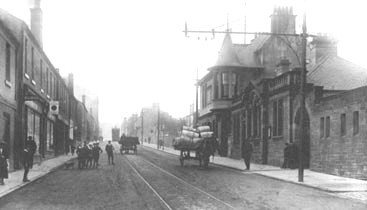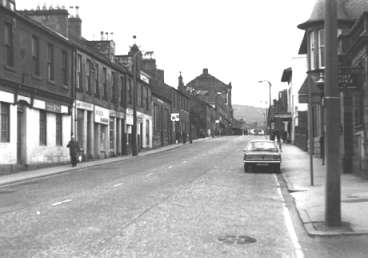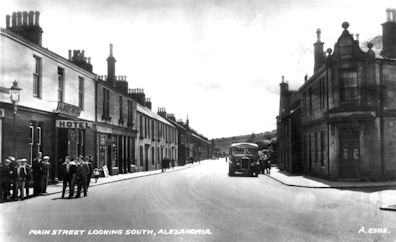Brief History of Alexandria 1800 - 2008 - Page 5
Page 1 | Page 2 | Page 3 | Page 4
From the 1850's onwards, the area had not been short of friendly societies such as the Oddfellows, the Loyal Order of Ancient Shepherds (1869), the Order of Foresters (1879), the Rechabites (1840's) and the Order of the Sons of Temperance (1869). You might have thought that you'd have to look pretty hard to find the space for yet another social organisation. Perhaps because these organisations are for the serious minded or the temperate, some Valemen did look pretty hard, and in 1910 founded the Natives and Residenters Association.
There was a pretty stiff qualification - you had to have lived in the Vale for 45 years - which meant if you weren't born in the Vale, you had to have arrived here no later than 1866. They held their inaugural dinner in the Albert Hotel in Alexandria on Friday 4th March 1910, starting at 7.45 pm. This was not an evening for the faint hearted, nor the weak stomached. It was a Friday, but in those days most of the attendees would be working on the Saturday morning. It started at 7.45 and had no less than 11 toasts. As if that wasn't enough there were 29 songs, yes 29, 9 Replies, 4 Remarks and 4 Recitations. Add on the food and you wonder, not so much what state they went home in. You don't have to be a rocket scientist to figure that one out, but what on earth time did it finish - indeed did it finish - and how many of them made it to their work the next morning?
Some of them must have survived because the Association soldiered on until shortly after the Second World War, by which time presumably the thought of another 29 songs just proved too much - it's a pity they couldn't have hung on until the invention of the karaoke machine. Unfortunately, no information exists about any of their subsequent dinners.
 In
December 1911, the area experienced its first major strike in nearly 50 years,
when the workers went on strike at all UTR factories for more money. The strike
lasted a couple of weeks, and was naturally very high profile in Alexandria
with meetings and demonstrations virtually every day.
In
December 1911, the area experienced its first major strike in nearly 50 years,
when the workers went on strike at all UTR factories for more money. The strike
lasted a couple of weeks, and was naturally very high profile in Alexandria
with meetings and demonstrations virtually every day.
The matter was raised in Parliament and shortly thereafter the government arbitrator got involved. A settlement for the men was arrived at in a day or so. The settlement for women, however, took many weeks to agree. (Picture: Bank Street Alexandria in the early 1900's.)
The early 1900's also saw a lot of new activity on the entertainment front. Moving pictures were a recent development. They had been shown occasionally as a one-off speciality event from 1899 to 1909 in both the Public Hall and the Co-op Halls. As already mentioned the Public Hall got a licence and was adapted to show movies in 1911. For a time it renamed itself “The Bioscope”, but returned to being called the Hall Cinema which it stayed until 1973 when it was turned into its current use as a bingo hall. For a number of years the Hall continued to combine films and live entertainment in the one program, and was still used periodically for public meetings. For a time it lagged behind the Strand in local popularity. However it changed hands shortly after the Second World War and the new owners, the Methven family, undertook major refurbishment in the mid 1950's. From then on the Hall and the Strand competed as equals.
In 1911, too, a theatre was added to the range of entertainments available in Alexandria when the Vale Empire was opened by a Mr Boyd. There is a record of a theatre in Alexander Street, the Prince of Wales, about 30-40 years previously but very little is known about it. Mr Boyd obviously felt there was still a place in the market for a commercial theatre, and he converted an old chemical works in Steven Street, just about where the Co-op Funeral Parlour now is.
The Empire was not only a venue for all the music hall acts, which did the rounds of Scottish local theatres, it also hosted touring plays and musicals. And it was where local theatrical and operatic societies put on their shows. While there aren't many people around now who have personal recollections of the Empire, previous generations loved to recall mishaps from shows, especially local shows. A favourite was how the moon hung down in front of a row of houses in the scenery of one play.
Vale Memories by Malcolm Lobban
Rough notes on life in the Vale of Leven circa 1938 to 1956 (un-published) and recorded in June 1994 for the Local History Section of Dumbarton Library.
The empire did well to survive until 1935, especially since a very near neighbour was the Strand Cinema in Bank Street, which almost backed onto the Empire. The Strand originally opened in 1914 as The Palace Cinema. It was purpose-built to show moving pictures. It was renamed the Strand in 1929 which it stayed until it showed its last picture in 1978. Charlie Wingate was its owner for most of its time as a cinema, and when Charlie died the Wingate family ran it for a time. For the initial part of its life, it was regarded as the more up-market of the two Alexandria cinemas - the seats were a bit more comfortable, the rake on the ground floor gave better sight lines to the screens from the seats, and the Strand usually got the big name films first.

The Old Bank Street Alexandria in the Early 1970's
The hey-day for both the Hall and Strand cinemas was of course the 1940's and 50's, when programs changed twice a week and there were queues at the weekend and even during the week for more popular films. At the Strand there were 2 “houses” i.e. screening of the films, nightly, one at about 6 pm, the second about 8.30 pm. The Strand had the additional advantage of showing a “matinee” every Saturday morning for children, for which the admission charge was for many years sixpence. For generations of Vale children their introduction to films was on a Saturday morning at the Strand.
After it closed as a cinema, it continued in use an indoor market and games arcade. It was closed for some time until it was demolished in 2004 to make way for the Aldi store which lies just outside the north-western side of the old Strand building. Attached to that side of the Strand was a shop. This was initially an opticians and in its latter years was a greengrocers owned by Iain McGregor.
The First World War had the same impact on Alexandria as on any other part of Britain. Young men marched off and many of them never returned, and many who did return carried sever wounds.
On the home front, Alexandria people learned new skills in the manufacture of explosives and munitions. Armstrong Whitworth, an armaments and munitions manufacturer acquired the Argyll Works in 1915 and started munitions production there. On the adjacent grounds of Argyll Park, which included the cricket club ground, just across the Heather Avenue from the works, they built a semi-underground complex for the production of explosives.
This complex was a network of bunkers, sunk to protect the outside world from any blasts from accidents in the manufacturing process, and pits in which low-level tests were carried out. The explosive being manufactured there was called Lyddite. Lyddite was itself yellow, and the skin of people working on Lyddite production turned yellow. It was obviously an unhealthy environment in every respect, and made a deep impression on the Vale collective memory for a couple of generations.
Many of the people working with Lyddite were the Vale's latest immigrants - refugees from Belgium. Many of them were housed in the newly-built Admiralty Cottages which were on the south-east corner of what is now Levenvale They were also popularly known as “The Huts”. At the outbreak of War, the Germans swept through much of Belgium in an attempt to outflank the French, and deny the British army access to the seaports through which it could support the French.
The Germans almost succeeded, but not quite. The British army arrived just in time to hold the strategically important town of Ypres, and a very narrow strip of land around it. This British-held area denied the Germans access to the French channel ports., but the price was excruciatingly high. Many of the worst battles of the First World War took place in this part of Belgium, and from an early part of the war, it was clear that all towns and villages in the battle zone were going to be destroyed. The Allies therefore evacuated all civilians from the parts of Flanders which they controlled, in early 1915. Some of these refugees came to Alexandria, and they worked in the Lyddite for the duration.
It may not have been pleasant or very healthy, but back home every village and town was totally obliterated - not one single building was standing in Ypres, a town of 40,000, at the end of the war - while the horrific military casualties tell what the cost was of being there at all. At the end of the war, the Belgians all went home by about 1920 to begin a twenty year task of rebuilding their homes, more or less completed just in time for the Germans to arrive again. Perhaps surprisingly, there is no trace at all of their years in the Vale. Then again, perhaps it is not so surprising. Even with the best efforts of the Vale people to make them welcome, what was happening to their homes must have been heart-breaking. Also they were in a foreign land, and the work they were carrying out, while it was important for the war effort, was hardly of their own choosing. You could well understand if their memories of their time in Alexandria were not happy ones, and they thought them best forgotten.
Page 1 | Page 2 | Page 3 | Page 4



